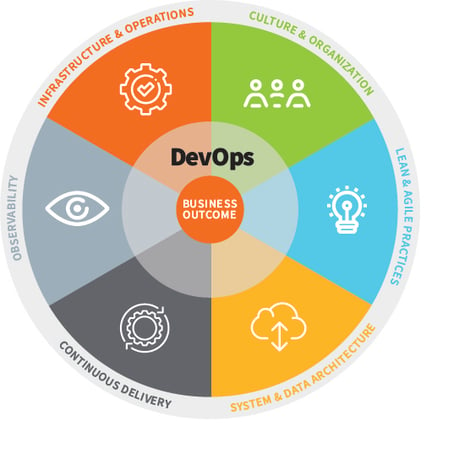IT leaders are on an endless hunt to improve their organizations in ways that are cross-functional and efficient. Naturally, DevOps is often explored as a potential solution.
The results speak for themselves: businesses successfully adopting DevOps are outperforming their peers. According to the DORA 2018 State of DevOps report, in the last year alone, high-performing DevOps organizations deployed 46x faster than their peers. Time to restore services took place an average of 2,604 times faster than with low-performing DevOps competitors. DevOps has a proven track record of success, which should make adoption relatively simple, right?
Unfortunately, most DevOps attempts—combining software development with IT operations for improved organizational agility—will fail. According to Gartner, by 2022 75 percent of all DevOps initiatives will not realize full business value. Without the right approach, the utopian concept of DevOps could very quickly translate to large amounts of wasted time, money, and effort.
The truth is, most DevOps failures can be chalked up to several specific errors made along the way. Gaining an early understanding of these issues can help you to anticipate problems, course correct, and quickly get back on the right track. From a lack of focus to planning failures, here are four primary reasons DevOps initiatives fail.
DevOps Failure #1: A Lack of Vision
Despite good intentions, some DevOps initiatives will fail before they even get off the ground. A lack of vision or strategic planning is to blame. Often, IT leaders feel pressure to “do DevOps,” but don’t take the time to identify expedient and sustainable strategies. Without set performance goals, your team wanders aimlessly.
IBM is a leader in DevOps solutions, but the tech giant grappled with its own transition back in 2008. Their adoption of agile to speed up development was ambitious but required a total overhaul of project conception and execution. A full value-chain analysis was required to identify the problems slowing them down. Now, instead of a 30-day kickoff plan, IBM can use DevOps to move projects into the next sprint within 48 hours.
According to DevOps expert John Esser, you must first establish your “why” for a DevOps transformation, then ground it in business value. A clear vision regarding desired results will allow you to maximize your time and resources, gain executive buy-in, and allow DevOps to work for you instead of against you.
DevOps Failure #2: Setting Unrealistic Expectations
Building faster, more secure systems does not take place overnight. Promising a quick turnaround without proper understanding of the task ahead is problematic in private, hybrid, and public cloud environments.
Perhaps you are working toward speed of delivery improvement, better virtual machine lifecycle management, or project automation. Rushing through the DevOps process can leave your teams in disorganized chaos.
Bank of America began a major cloud migration back in 2012. After seven years of work, they have saved billions in hardware costs and improved customer interactions. By the end of 2019, they will have successfully moved 80 percent of their infrastructure to their private cloud, with expedited plans to complete the remaining 20 percent.
For Bank of America, slow and steady migration helped them to gain confidence in their cloud operations, gather insight from clients, and make a major shift without interrupting business operations. You can view their story here.
In John Esser’s guidebook, Navigating your DevOps journey , the author recommends mapping out a 3-5 year plan of execution, depending on the needs of your business. Planning a consistent, step-by-step approach will set realistic expectations for a transformation that sticks.
DevOps Failure #3: The Infamous DevOps Team
It may sound counterintuitive, but a DevOps team is not necessary when implementing a DevOps strategy. Because DevOps revolves around the elimination of bottlenecks and breaking down silos, the creation of yet another silo is often unhelpful. Naming a DevOps team also puts up a barrier to buy-in. These new principles work best when applied across the organization-- not to a single team.
There are proven methods for transitioning from an initial DevOps implementation team to company-wide adoption. To learn more, check out the webinar: Avoiding the Infamous DevOps Team.
DevOps Failure #4: Not Taking a “Holistic” Approach to DevOps
At its core, a DevOps shift is cultural. It requires a change in philosophy before details like tools, speed, and applications are addressed. An unbalanced approach will yield equally unbalanced results, and even the most efficient tools will fail without support from the right people and processes.
In a story published by InfoWorld, DevOps consultant Brian Dawson experienced similar failure while working on a government project. The goal was to develop a fast-paced agile tool. The platform concept came together quickly, but the group skipped crucial developer and user buy-in and performance data. “Though we had a ‘DevOps platform’ in place, it was effectively used to support the same old legacy practices,” Dawson tells InfoWorld. The result was months of costly technical fixes with little progress to show for it.
Taking the holistic approach to DevOps can help to create balance and contribute to long-term healthy growth of your organization. To achieve this, our experts recommend addressing six unique areas simultaneously to achieve lasting results.
These areas are:
- Infrastructure & Operations
- Culture & Organization
- Lean & Agile Practices
- System & Data Architecture
- Continuous Delivery
- Observability
 True DevOps harmony is possible when all six areas are balanced and optimized.
True DevOps harmony is possible when all six areas are balanced and optimized.
According to Gartner Senior Director Analyst George Spafford, people have the power to fix most the DevOps problems with an incremental, iterative approach. “Organizational learning and change are key to allowing DevOps to flourish,” Spafford says. “In other words, people-related factors tend to be the greatest challenges—not technology.”
Lasting transformation is possible with a comprehensive view of the top reasons why DevOps projects fail—and a people-first plan to avoid them.
Schedule a free hour with one of our solutions experts to begin your DevOps journey the right way.

Sources:

 True DevOps harmony is possible when all six areas are balanced and optimized.
True DevOps harmony is possible when all six areas are balanced and optimized.
